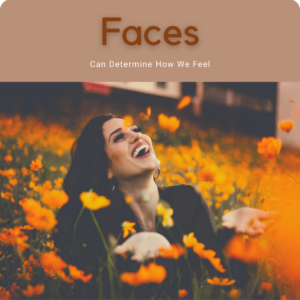 Your face reflects the emotions you feel. This is obvious: When we are sad we frown. When we are angry our eyes get smaller and everything on our faces becomes more horizontal and set. When we are happy our eyes light up and we smile. And we can instantly tell the difference between a real smile and a fake one. Did you ever wonder, or notice, what the difference actually is? In a real smile, the tiny muscles of the bottom eyelid move upward in a crescent. Before I learned this a few years ago, I couldn’t have told you what the difference was—I just knew it when I saw it. Our intuitive understanding of facial expressions is part of our empathy and ability to connect to others. Facial expression is a huge part of nonverbal communication.
Your face reflects the emotions you feel. This is obvious: When we are sad we frown. When we are angry our eyes get smaller and everything on our faces becomes more horizontal and set. When we are happy our eyes light up and we smile. And we can instantly tell the difference between a real smile and a fake one. Did you ever wonder, or notice, what the difference actually is? In a real smile, the tiny muscles of the bottom eyelid move upward in a crescent. Before I learned this a few years ago, I couldn’t have told you what the difference was—I just knew it when I saw it. Our intuitive understanding of facial expressions is part of our empathy and ability to connect to others. Facial expression is a huge part of nonverbal communication.
So we know that our faces convey how we feel. But did you know that faces can determine how we feel? Or to be more precise, changing the expression on our faces can change the emotions we experience. Since the 1980’s, researchers have found the putting a smile on makes us happier. Sales trainers have been recommending for decades that we put a smile on our faces before picking up the phone because it will make us sound happier and more likable.
More recently, researchers have found that the smile doesn’t even have to be genuine. We can “fake it till we make it”. Mori and Mori of the University of Tokyo conducted a study, published in 2009, using rubber bands and latex bandages to force participants’ cheeks upward in a smile position, or downward in a frown. In the smile position, the participants felt happier, and in the frown position, they felt sad. A follow-up study published in 2013 found that the smilers had a better opinion of others when they were smiling. Wow. We can plaster on a fake smile and not only feel happier, we’ll like people more.
And then there is the work of Amy Cuddy, a social psychologist, and researcher who investigates body language and facial expression. She presented one of the most popular TED talks ever; you can see it here. In her talk, Cuddy explains how our posture and facial expression affect our mood. She shares lots of tips on how we can use our bodies to feel more powerful and happy. One of her suggestions is to put a pencil in our mouth to force our cheeks back into a smile position in order to feel happier.
I used to love sharing this with my students when I taught at the local community college. I would sometimes ask them to put their pencils or pens between their teeth to see if they started feeling happier. Usually, they wound up laughing, probably because we all looked a little ridiculous. I have also used this knowledge to my own advantage many times. When I start to feel unhappy, I try to remember to plaster a smile on my face. Soon enough, I’m back to feeling peaceful and happy.
If you decide to test this out for yourself, I’d love to hear how it goes—leave a comment below!
